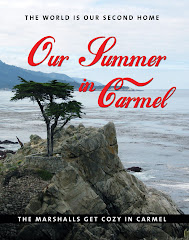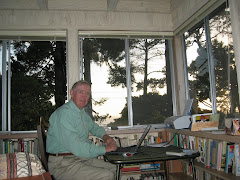
THE PINE INN AFTER RELOCATION. MIGHT EVEN BE DEVENDORF'S BUGGY.

THE PINE INN TODAY EXPANDED BUT IN THE SAME LOCATION.
EXCERPT FROM MY BOOK: OUR SUMMER IN CARMEL, AMAZON.COM
The square mile incorporated city of Carmel-by-the-Sea, in addition
to the 120 galleries and art studios, also claims two stage theaters,
the internationally acclaimed Bach Festival, the equally renowned
Shakespeare Festival, a music society, and an annual art festival among
its more prominent cultural events. This focus on the arts is not a recent
Chamber of Commerce effort to boost tourism. Unlike other California
real estate developments around the turn of the 19th Century, from the
onset Carmel was a settlement of artists.
The original inspiration for developing Carmel came from the
neighboring town of Pacific Grove. In that small seaside community
during the 1880’s, a group of people representing the Methodist Church
established a summer retreat. A retreat that attracted adherents to
the Chautauqua Movement, a turn-of-the century Christian based,
cultural-enlightenment and self-improvement program. The original
developer of present day Carmel thought that, because of the Carmel
Mission’s proximity, (the Serra Mission incidentally was in the process
of restoration,) the developer could emulate Pacific Grove’s Methodist
oriented success with, in this case, a retreat for Roman Catholics. His idea
did not succeed for several reasons. First, Carmel was difficult to get to.
The developer’s promise (hope) that the railroad from Monterey would
be extended to reach the Carmel Mission never happened. Additionally,
in the early 1890s, the national economy entered into a recession, causing
the bloom to fade on California tourism and discretionary spending
for second homes. Adding to these woes was the reality that Carmel
was very isolated when compared to Pacific Grove, discouraging even
the wealthiest and most enlightened Catholics. The original Carmel
developer, Santiago Duckworth, in an attempt to redirect his marketing
plan away from duplicating the religious theme of Pacific Grove, had the
town renamed “Carmel-by-the-Sea.” He built a bathhouse on the beach
and a small hotel to accommodate buyers who remained overnight as they
pondered the purchase of a lot in Carmel. Duckworth’s efforts could not
overcome the geographic disadvantages, and he was rapidly running out
of money and personal enthusiasm. Enter Frank Devendorf.
Devendorf, when visiting the Monterey area several years earlier, had
seen Carmel beach and was enthralled by the scenery and landscape. He
was an experienced realtor, having been instrumental in the development
of such communities as Morgan Hill and Santa Cruz in the San Francisco
bay area. When Duckworth came to him, looking for a way out of his
Carmel project, it did not take long for Devendorf, who was already
captivated by Carmel, to swap real estate he owned in the Stockton area
for Duckworth’s Carmel holdings. The forty-six-year-old Devendorf
then teamed with Frank Powers, a successful San Francisco attorney,
heir to a family fortune from the gold rush days, and an energetic and
far sighted outdoorsman. Together, they made an unbeatable team, being
perfectly matched for the development of Carmel. Each man had his
own vision beyond just making Carmel a financial success.
Devendorf had always prided himself on building enduring communities, not simply
exploiting California’s real estate boom and bust cycle. He had a populist
background, influenced by Teddy Roosevelt’s politics and a Jeffersonian
heritage. Powers was a driven man, interested in the restoration of the
Carmel Mission and exploring the wild coast south of Carmel. They each
shared an interest in preserving the landscape, not an interest generally
ascribed to by developers during their time. Powers also brought
financial resources and legal and business connections to the partnership;
Devendorf, the on-site management savvy for real estate development.
They formed the Carmel Development Company in 1902, and the rest
is history.
Devendorf traveled by horse and buggy every Monday from his home
in Berkeley to his office in Carmel, where he would spend the remainder
of the week. He was the partner who showed the land, set the terms of
sale, and encouraged growth. Weary by Friday, he made the long trip back
to Berkeley. He was creative. He used log rollers to move the hotel that
Duckworth had built to a more central location in the middle of Carmel,
renaming it the Pine Inn. Greatly expanded, the Pine Inn is in the same
location today, a landmark Carmel hotel. Relocating the hotel was not an
easy feat. Ocean Avenue, at the time, was no more than a steep, rutted
and pitted grade cursedly named the Devil’s Staircase. During heavy rain,
it became an uncontrolled rivulet instead of a main street.
From these humble beginnings, just over one-hundred years ago Carmel began to grow from an inaccessable wilderness, and in so doing attracted a different sort of resident; one that would put its stamp on the character of the place, forever.
 GRETEL 1925
GRETEL 1925
 HANSEL 1924
Two adorable Hugh Comstock fairy tale cottages epitomize Carmel's development.
Excerpted from my book: OUR SUMMER IN CARMEL-AMAZON.COM
Over the years, builders such as Hugh Comstock in the 1920s, constructed
quaint cottages that came to symbolize Carmel’s special character; and
special it really is! Paving the streets was a hotly debated development issue
opposed by many as an act of “boosterism” that catered to commercial
interests. Neon signs were banned, and even today, Carmel’s bars are not
allowed to have live entertainment because they would attract the “wrong
crowd.” But changes in lifestyle, over time, can erode even the strongest
will to resist altering what was once accepted and honored. Holding on to
the past while resisting the power of money and change is impossible. The
Carmel artistic colony today strives hard to retain its former charm. The city
clings to its unique traditions such as no mail delivery and no stop lights,
and promotes the arts to an extraordinary level considering its small size.
But one also gets the sense that paying homage to quaint traditions also has
something to do with presenting an attractive image; an image that caters to
what visitors have come to expect. Keeping Carmel somewhat like “earlier
Carmel,” is what the visitor is mostly looking for; but not necessarily what
residents today want for themselves. Tourism has won the battle that was
fought between earlier Carmelites, some of whom sought to preserve the
idea of an artistic enclave, and others who wanted to modernize and develop.
The city planning document of 1929 had an extraordinary mission statement,
especially considering the rampant commercialism of the time:
"The city of Carmel-by-the-Sea is hereby determined to be primarily,
essentially and predominantly a residential city wherein business and commerce
have in the past, are now, and are proposed to be in the future, subordinated to
its residential character."
Today, property interests, meaning the all-encompassing real estate
sector, dominate Carmel-by-the-Sea’s commerce. Housing is so expensive
only the elite can afford to own a home. The days of the underpaid
artist, poet, or writer starting out in life with little but their inspiration,
seeking the solitude of Carmel to nurture their talent among kindred
souls, has long ago left the scene. Carmel is delightful and entertaining.
The inhabitants are successful, culturally sensitive, and intelligent. Their
lifestyle is like few places in the world. But Carmel-by-the-Sea is no
longer a small town village or a unique place of artistic inspiration.
HANSEL 1924
Two adorable Hugh Comstock fairy tale cottages epitomize Carmel's development.
Excerpted from my book: OUR SUMMER IN CARMEL-AMAZON.COM
Over the years, builders such as Hugh Comstock in the 1920s, constructed
quaint cottages that came to symbolize Carmel’s special character; and
special it really is! Paving the streets was a hotly debated development issue
opposed by many as an act of “boosterism” that catered to commercial
interests. Neon signs were banned, and even today, Carmel’s bars are not
allowed to have live entertainment because they would attract the “wrong
crowd.” But changes in lifestyle, over time, can erode even the strongest
will to resist altering what was once accepted and honored. Holding on to
the past while resisting the power of money and change is impossible. The
Carmel artistic colony today strives hard to retain its former charm. The city
clings to its unique traditions such as no mail delivery and no stop lights,
and promotes the arts to an extraordinary level considering its small size.
But one also gets the sense that paying homage to quaint traditions also has
something to do with presenting an attractive image; an image that caters to
what visitors have come to expect. Keeping Carmel somewhat like “earlier
Carmel,” is what the visitor is mostly looking for; but not necessarily what
residents today want for themselves. Tourism has won the battle that was
fought between earlier Carmelites, some of whom sought to preserve the
idea of an artistic enclave, and others who wanted to modernize and develop.
The city planning document of 1929 had an extraordinary mission statement,
especially considering the rampant commercialism of the time:
"The city of Carmel-by-the-Sea is hereby determined to be primarily,
essentially and predominantly a residential city wherein business and commerce
have in the past, are now, and are proposed to be in the future, subordinated to
its residential character."
Today, property interests, meaning the all-encompassing real estate
sector, dominate Carmel-by-the-Sea’s commerce. Housing is so expensive
only the elite can afford to own a home. The days of the underpaid
artist, poet, or writer starting out in life with little but their inspiration,
seeking the solitude of Carmel to nurture their talent among kindred
souls, has long ago left the scene. Carmel is delightful and entertaining.
The inhabitants are successful, culturally sensitive, and intelligent. Their
lifestyle is like few places in the world. But Carmel-by-the-Sea is no
longer a small town village or a unique place of artistic inspiration.
























